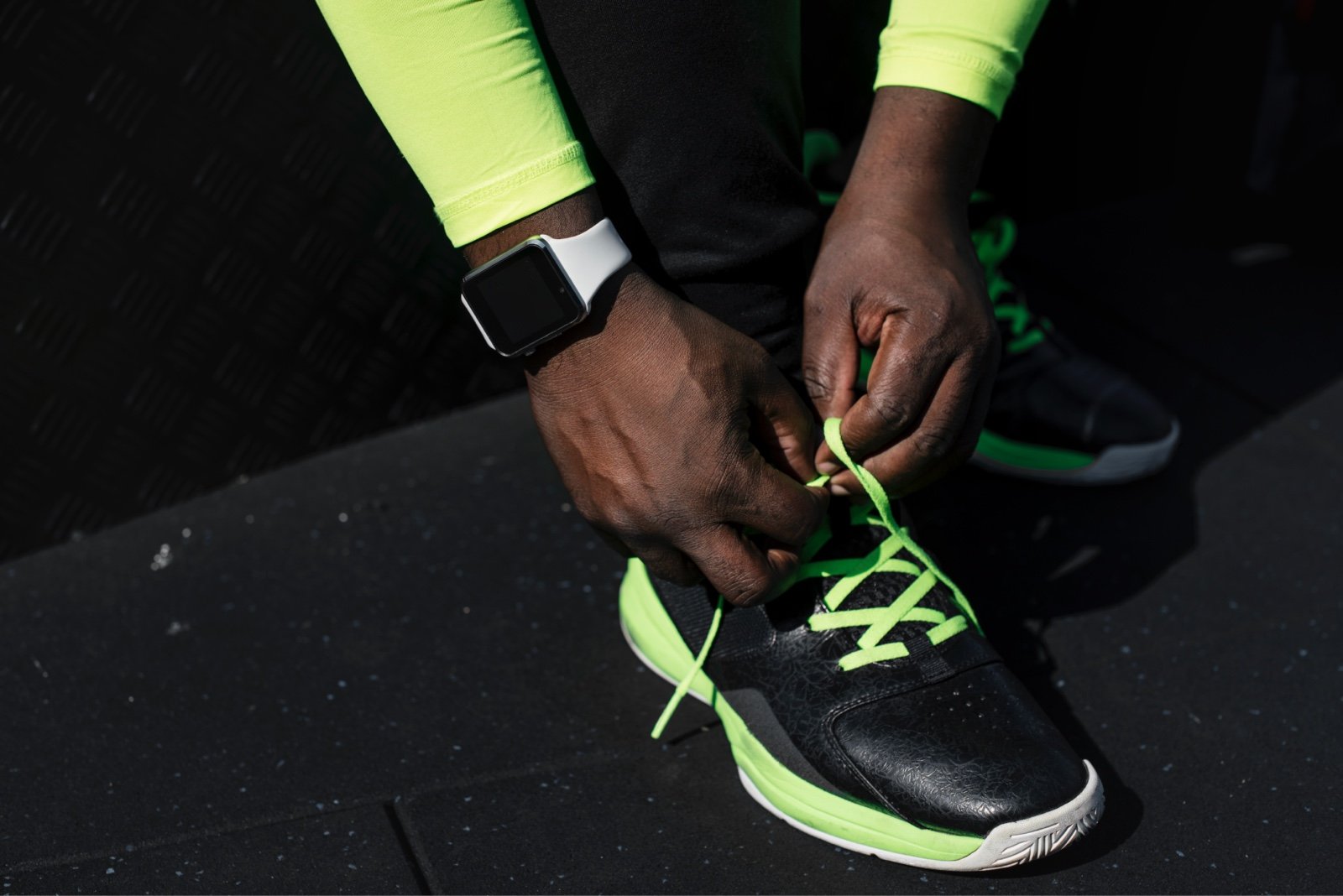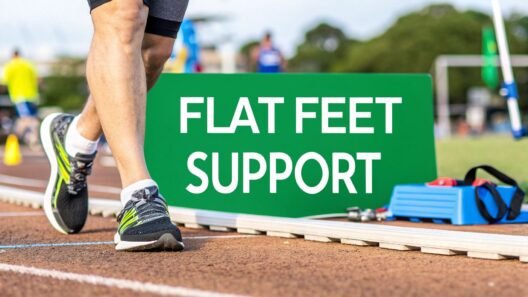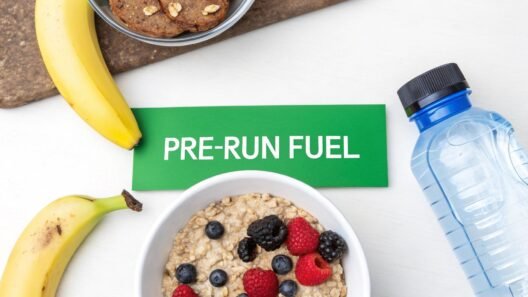So, you're thinking about running a half marathon. The first question on everyone's mind is always the same: how far is it, really?
The official distance is a precise 13.1 miles, which works out to be exactly 21.0975 kilometers. This specific length has made the half marathon one of the most popular race distances on the planet. It’s a serious endurance challenge that demands respect and training, but it’s far more accessible than its big brother, the full marathon.
The Magic Number: 13.1 Miles
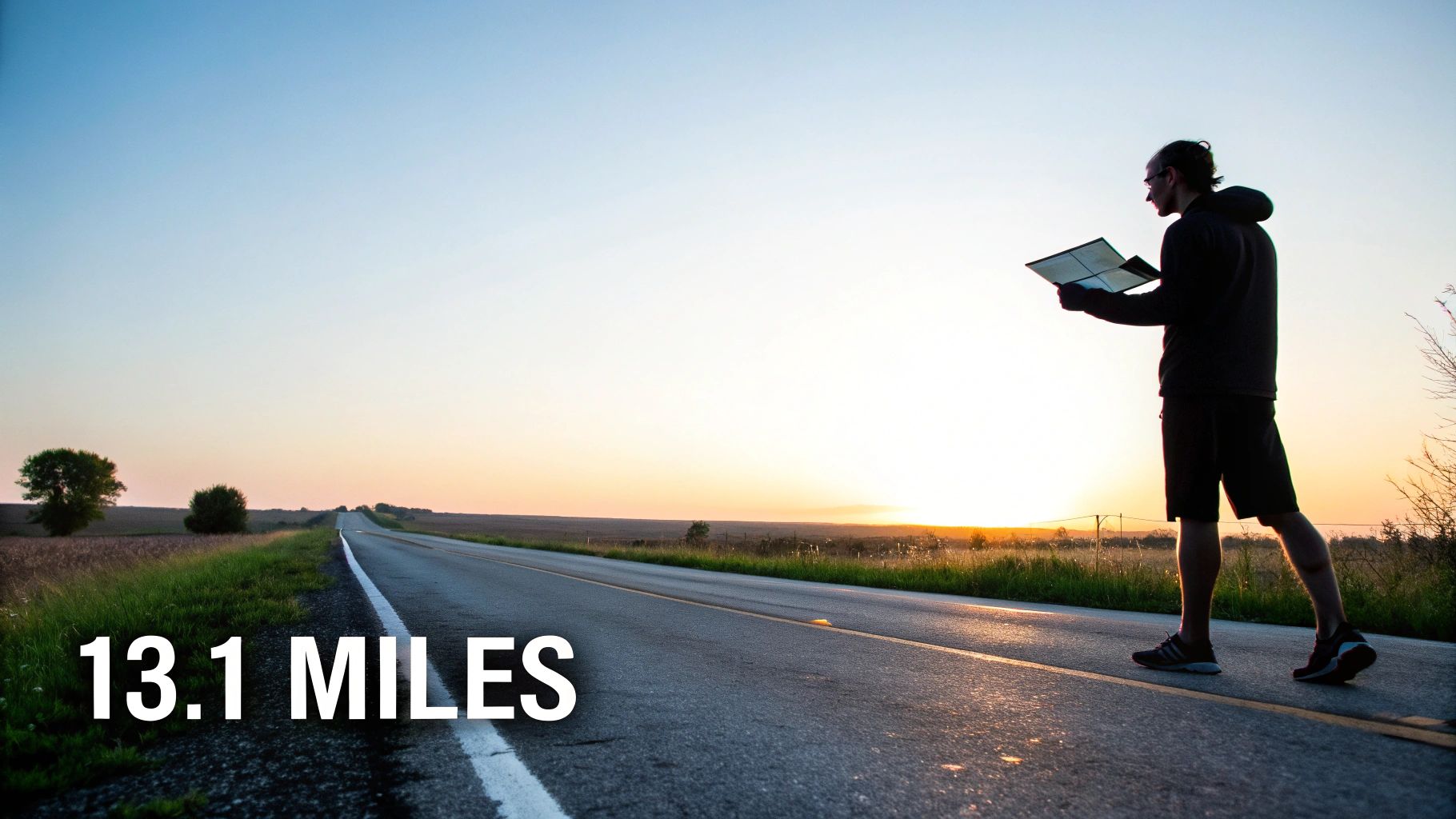
No matter where you lace up your shoes—New York, London, or a small town race—the distance is always the same. This global standard ensures that your finish time in one certified race is comparable to another, which is crucial for tracking personal bests and official records.
So, where did that very specific number come from? The official distance is technically 21.0975 kilometers, which converts to 13.1094 miles. Runners everywhere just round it down to 13.1 miles for the sake of simplicity. This standard was locked in by World Athletics to create consistency across all officially sanctioned events. You can dive deeper into the history of the half marathon distance to see how it evolved.
Getting comfortable with both miles and kilometers is a smart move, especially if you use a GPS watch or training app that defaults to metric. Thinking about the race in smaller, familiar chunks—like hitting the 5k or 10k mark—can also make the full distance feel much less intimidating.
To give you a better feel for the course, here’s a quick reference table breaking down the key race milestones in both miles and kilometers.
Half Marathon Distance Breakdown Miles vs Kilometers
| Milestone | Distance in Miles | Distance in Kilometers |
|---|---|---|
| 5K Mark | 3.1 miles | 5 km |
| 10K Mark | 6.2 miles | 10 km |
| Halfway Point | 6.55 miles | 10.55 km |
| Finish Line | 13.1 miles | 21.0975 km |
Seeing these numbers laid out helps you visualize your progress on race day. Each milestone is a small victory on your way to that glorious finish line
What’s the Big Deal With 13.1 Miles?
Why do millions of people get hooked on running 13.1 miles? The half marathon really is the sweet spot in the running world. It’s a genuinely tough endurance challenge that you absolutely have to train for, but it doesn't demand the same all-consuming commitment as a full marathon. That unique balance makes it the perfect target for almost every type of runner.
For someone just getting into distance running, finishing a half marathon is a huge milestone. It’s the kind of achievement that proves your dedication and gives you a massive jolt of confidence. On the flip side, veteran marathoners often use a half marathon as a "sharpener" race to dial in their speed and check their fitness without the brutal recovery of a full 26.2-miler.
The Ideal Race Distance
This versatility is exactly why the distance has seen such a massive boom over the last 20 years. For a while, it was the fastest-growing race distance in the U.S., and global race data consistently shows it's the second most popular distance worldwide. It's a global phenomenon, and you can see more stats on the half marathon's rise on Wikipedia.
The half marathon hits that perfect intersection of challenge and achievability. It tests your physical and mental grit but doesn't require you to rearrange your entire life the way a full marathon can. It’s a goal that feels both inspiring and realistic.
That wide appeal creates an incredible energy on race day. You're surrounded by people hitting a massive personal goal for the first time, right alongside seasoned runners gunning for a new personal best. Knowing how many miles is a half marathon is just the start; understanding its pull is what inspires you to join them at the starting line and fall in love with the sport of running.
Decoding Your Half Marathon Finish Time
So, you've got the distance locked in. The next question that almost every runner asks is, "How fast can I actually run this thing?" It's a great question, but the answer is… it depends. Your half marathon finish time can swing wildly based on everything from your running background and age to the weather and how hilly the course is.
But we can still get a pretty good idea of what to expect by looking at the averages. A massive analysis of 35 million race results pins the global average half marathon time at 2 hours, 14 minutes, and 59 seconds.
Digging a little deeper, we see a split between genders. Men, on average, cross the finish line in 1 hour, 59 minutes, and 48 seconds, while the average for women is 2 hours, 24 minutes, and 3 seconds. These numbers aren't meant to be rigid standards, but they're a fantastic starting point for figuring out where you might fit in. You can dive into the full analysis of race data to see even more breakdowns.
Finding Your Target Pace
At the end of the day, your finish time is just a result of the average pace you can sustain for all 13.1 miles. For a huge number of runners, breaking the two-hour mark is a major bucket-list achievement. To do that, you need to hold a steady pace of 9 minutes and 9 seconds per mile (or faster!). On the other end of the spectrum, world-class elites are clocking times just under one hour. It's a mind-boggling pace.
The half marathon distance really hits a sweet spot for runners—it's a serious challenge that demands respect and training, but it's also an achievable goal that delivers a huge sense of accomplishment.

It's this blend of being a tough physical test and an incredible personal victory that keeps people coming back for more.
Key Takeaway: A "good" finish time is completely personal. If you're a new runner, just getting across that finish line is a monumental win. For a veteran racer, the goal might be shaving a few seconds off a personal best. Use the averages as a guidepost, not a judgment.
To make your goal a reality, you need to know exactly what pace to hit during your training runs and on race day. This pacing chart breaks down some of the most common time goals into the per-mile and per-kilometer pace you'll need to lock into.
Half Marathon Pacing Chart Finish Time Goals
| Finish Time Goal | Pace per Mile (min/mi) | Pace per Kilometer (min/km) |
|---|---|---|
| 1:30:00 | 6:52 | 4:16 |
| 1:45:00 | 8:01 | 4:59 |
| 2:00:00 | 9:09 | 5:41 |
| 2:15:00 | 10:18 | 6:24 |
| 2:30:00 | 11:27 | 7:07 |
| 2:45:00 | 12:35 | 7:50 |
| 3:00:00 | 13:44 | 8:32 |
Find your target time in the chart and start practicing that pace. Getting comfortable with how it feels is a huge part of successful race-day execution.
Building Your Half Marathon Training Plan

So, you know a half marathon is 13.1 miles. That's the easy part. The real question is how to get your body ready to cover that distance. You don’t just show up on race day and hope for the best; you build toward it, week by week, with a smart and structured plan.
Think of your training as an investment. Each run is a deposit into your fitness bank, and it all adds up to a huge payoff on race day. A good plan isn't about running yourself into the ground. It's about balancing different kinds of effort to get you stronger, faster, and more resilient.
Your weekly long run is the cornerstone of this whole process. This is the one non-negotiable workout where you gradually extend your mileage, teaching your body how to burn fuel efficiently and your mind how to stay tough when you get tired. It's all about time on your feet.
But you also need to add some speed work. These faster workouts are what sharpen your fitness, making your goal pace feel more manageable and even comfortable. And just as important are the rest days. That's when the real magic happens—your muscles rebuild, adapt, and come back stronger. Skipping rest is a surefire recipe for burnout or injury.
The Key Types of Runs in Your Plan
A good plan will mix and match a few core workouts, each with a specific job to do. You won't do them all every week, but knowing what they are and why you're doing them makes all the difference. A well-designed running schedule for beginners will carefully layer these in over time.
- The Long Run: This is your endurance session, almost always done on the weekend. The pace should be easy enough that you can hold a conversation. The goal here isn't speed; it's simply covering the distance.
- Tempo Runs: Think of this as a "comfortably hard" pace you can hold for a sustained period, maybe 20-40 minutes. Tempo runs are incredible for raising the threshold at which your body gets tired.
- Interval Training: This is where you really work on your speed. It involves short, fast bursts of running with recovery jogs in between. Intervals are fantastic for improving your running form and overall efficiency.
A great training plan isn't about running hard all the time. It's about running smart. The magic happens when you combine the stress of hard workouts with adequate recovery, allowing your body to adapt and grow stronger.
Most beginner plans last about 10 to 12 weeks. This gives you plenty of runway to build up your mileage safely and avoid injury. Your longest run before the race will probably top out around 10 to 11 miles. That's enough to give you the confidence that you can handle the full distance without completely draining your reserves. The idea is to arrive at the start line feeling strong and fresh, not exhausted from training.
Your Guide to Fueling and Hydration
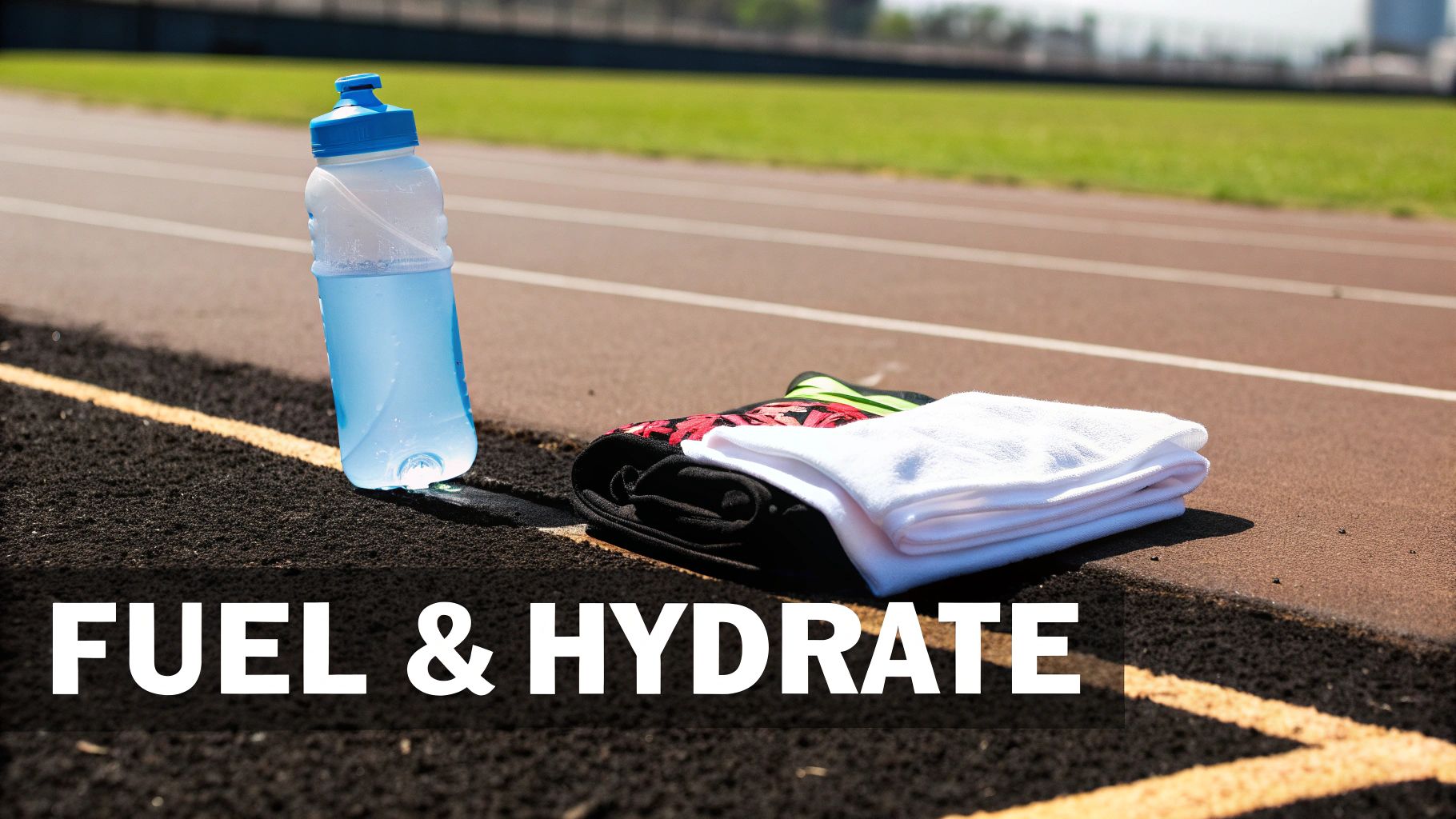
Running 13.1 miles is a whole different ballgame compared to a 5k or 10k. It's an endurance event, and that means you need to think about your fuel tank. Think of it like this: your body has enough stored fuel (glycogen) to run for about 90 minutes. For many runners, that’s not quite enough to get to the finish line without sputtering.
That's where a smart fueling strategy comes in. It all starts the day before with a good carb-heavy meal—think pasta, rice, or potatoes. This "carb-loading" tops off your muscles' energy stores. On race morning, have a simple, familiar breakfast at least 90 minutes before the gun goes off. A bagel with peanut butter or a bowl of oatmeal are classic choices for a reason.
Fueling During the Race
Once you're running, the clock starts ticking on those energy stores. To avoid hitting that dreaded "wall" where you feel completely out of gas, you'll need to start taking on fuel somewhere between 45-60 minutes into your race. From there, you'll want to keep topping up the tank.
A good rule of thumb is to aim for 30-60 grams of carbohydrates per hour. What you use is a matter of personal preference, but here are the most common options:
- Energy Gels: These are basically concentrated sugar shots. They’re quick, easy to carry, and designed for fast absorption. Just make sure to wash them down with some water.
- Energy Chews: If you prefer something to chew on, these gummy-like blocks offer the same kind of fuel as gels. Some runners find them easier on the stomach.
- Sports Drinks: The aid stations will likely have these. They're great because they deliver carbs, electrolytes, and fluids all in one go.
The golden rule of race day is simple: Nothing new. Seriously. Only use the exact gels, chews, and drinks that you’ve already tested on your long training runs. Your stomach will thank you.
And don't forget about hydration! It’s just as important as the calories. Take a few sips of water or a sports drink at every aid station, even if you don't feel thirsty. By the time you feel thirsty, you're already on your way to being dehydrated. Nailing your nutrition is a massive part of what gets you across that finish line feeling strong.
Nailing Your Race Day Strategy
You've put in months of hard work and logged countless miles. The last thing you want is for a simple mistake on race morning to derail all that effort. A smart race day plan is just as important as any training run, setting you up to feel calm, confident, and ready to go when the gun fires.
The Night Before and Race Morning
Your race day success really starts the night before. Get everything—and I mean everything—laid out. Pin your bib on your shirt, set out your shoes and socks, and have your anti-chafe balm and fuel ready. This simple step completely removes any frantic, last-minute searching in the morning.
For breakfast, stick with what you know. Eat your usual pre-long-run meal at least 90 minutes before the race starts. This gives your system plenty of time to digest, so you're not dealing with any surprises on the course.
Tackling the 13.1 Miles
Once you get to the start line, a little light jogging and some dynamic stretches are all you need to get your muscles firing. The biggest rookie mistake? Going out way too fast. Be realistic about your goal pace and line up in the right corral. A fast first mile often leads to a painful final few.
The most powerful tool you have on race day isn't your legs—it's your head. Don't think about the entire 13.1 miles at once. That's overwhelming.
Instead, slice the race into smaller, more digestible pieces. Try thinking of it as three separate 4-mile runs, followed by a final 1.1-mile victory lap to the finish line. This mental game keeps you focused on the mile you're in, helping you conserve energy and run a much smarter race all the way to that finish line.
Common Questions About the Half Marathon
As the idea of tackling 13.1 miles starts to feel more real, some practical questions always pop up. Getting these answers sorted out is key to moving from the "maybe" stage to confidently toeing the starting line. Let's break down a few of the most common things runners wonder about.
How Long Does It Take to Train for a Half Marathon?
For a beginner just getting into distance running, a 12 to 16-week training plan is the sweet spot. This timeframe gives your body the chance to adapt to the new mileage slowly and safely, strengthening your muscles and joints without pushing you into injury territory.
If you’ve already got a few races under your belt and are shooting for a new personal best, you might opt for a shorter, more intense 8 to 10-week plan. This is usually enough time to fine-tune your fitness and lock in your goal race pace.
Can I Walk a Half Marathon?
You absolutely can! Walkers are a welcome and celebrated part of many half marathon events. The one thing you need to double-check before signing up is the official course time limit.
Most races give you between 3.5 and 4 hours to finish. That works out to a pace of about 16-18 minutes per mile, which is a very manageable goal for a brisk, steady walker. Just be sure to confirm the specific cut-off time on the race website so you know you'll have a stress-free day.
Is a 10K Harder Than a Half Marathon?
While both are impressive accomplishments, the half marathon is a much tougher beast. A 10K is 6.2 miles; a half marathon is more than double that at 13.1 miles, and that extra distance completely changes the game.
Think of it this way: a 10K tests your speed and grit, but a half marathon is a true test of endurance. It demands much more from your body's energy stores, your hydration strategy, and your mental game over a far longer period.
Can You Run a Half Marathon Without Training?
This is a really bad idea. Trying to run 13.1 miles cold, without any structured training, puts you at a huge risk for injury. We’re talking about everything from debilitating muscle tears to stress fractures that could sideline you for months.
Training isn't just about covering the distance; it's about conditioning your entire body—muscles, bones, heart, and mind—for the stress of race day. To get started the right way, check out the expert guides at THE RUNNING. You can find everything you need on building a solid running foundation on the-running.com.





